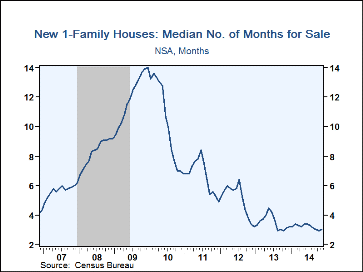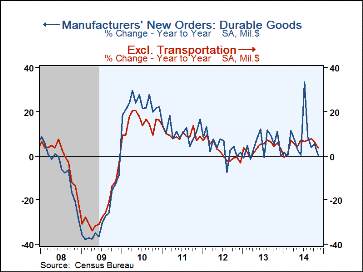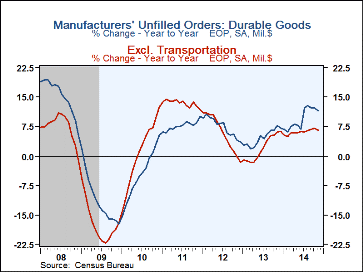 Global| Jan 02 2014
Global| Jan 02 2014U.S. Construction Spending Advances Further
by:Tom Moeller
|in:Economy in Brief
Summary
The value of construction put-in-place gained 1.0% in November (5.9% y/y) following a little-revised 0.9% October rise. A 0.6% increase in building activity had been expected. The September increase of 1.4% was revised up [...]
The value of construction put-in-place gained 1.0% in November (5.9% y/y) following a little-revised 0.9% October rise. A 0.6% increase in building activity had been expected. The September increase of 1.4% was revised up substantially from the initially-estimated 0.3% slip.
Private sector construction activity jumped 2.2% (8.6% y/y) in November after no change in October. Residential building surged 1.9% (16.6% y/y) as spending on improvements recovered 2.2% (10.2% y/y). Single-family home building activity gained 1.8% (18.4% y/y) while multi-family building rose 0.9%, up by more than one-third y/y. Nonresidential building activity surged 2.7% (1.0% y/y) paced by an 8.8% gain (37.7% y/y) in multi-retail and a 4.6% rise (11.5% y/y) in office building.
Offsetting these November gains was a 1.8% decline (-0.2% y/y) in the value of public sector building activity. The shortfall reflected an 8.1% drop (-4.6% y/y) in sewerage & waste disposal and a 7.3% shortfall (-9.1% y/y) in health care building activity. Spending on highways & streets slipped 0.4% (+4.6% y/y). Spending here accounts for 30% of total public sector construction activity.
The construction spending figures are in Haver's USECON database and the expectations figure is contained in the AS1REPNA database.
Tom Moeller
AuthorMore in Author Profile »Prior to joining Haver Analytics in 2000, Mr. Moeller worked as the Economist at Chancellor Capital Management from 1985 to 1999. There, he developed comprehensive economic forecasts and interpreted economic data for equity and fixed income portfolio managers. Also at Chancellor, Mr. Moeller worked as an equity analyst and was responsible for researching and rating companies in the economically sensitive automobile and housing industries for investment in Chancellor’s equity portfolio. Prior to joining Chancellor, Mr. Moeller was an Economist at Citibank from 1979 to 1984. He also analyzed pricing behavior in the metals industry for the Council on Wage and Price Stability in Washington, D.C. In 1999, Mr. Moeller received the award for most accurate forecast from the Forecasters' Club of New York. From 1990 to 1992 he was President of the New York Association for Business Economists. Mr. Moeller earned an M.B.A. in Finance from Fordham University, where he graduated in 1987. He holds a Bachelor of Arts in Economics from George Washington University.










